English (EN) / 中文 (ZH)
Dong Xiao, Broker - Partner (302)528-9501 dong.xiao@givingtreerealty.com
Research Triangle
The North Carolina Research Triangle area encompasses three major cities—Raleigh, Durham, and Chapel Hill—and their surrounding towns, spanning a total of nine counties. At the core of this region are Wake, Durham, and Orange counties, home to three prestigious research universities that anchor the area: North Carolina State University (NCSU), Duke University, and the University of North Carolina (UNC) at Chapel Hill. These institutions foster a highly educated workforce and contribute to a vibrant intellectual and cultural environment, establishing the Triangle as a premier hub for innovation, education, and culture in the southeastern United States.
Research Triangle Park
The “Triangle” name originated in the 1950s with the creation of Research Triangle Park (RTP), which is centrally located in the Triangle area. Spanning over 7,000 acres, RTP is the largest research park in the United Sates, hosting more than 375 companies. These businesses range from global tech giants to biotech startups, making the park a driving force for job creation and innovation in sectors such as technology, life sciences, and environmental research. RTP’s proximity to renowned research universities ensures a continuous flow of skilled researchers, engineers, and professionals, bolstering the region’s economic foundation and enhancing its reputation as a hub of innovation and discovery.


IBM has long been among a significant presence at Research Triangle Park, employing approximately 8,000 people at its facilities. Its long-standing influence highlights RTP's reputation as a hub for innovation and technology. In addition to IBM, GlaxoSmithKline (GSK) operates one of its largest research and development centers in the park, with around 5,000 employees driving cutting-edge advancements in the biotech and pharmaceutical fields. Cisco Systems also plays a critical role in RTP’s ecosystem, with its campus here serving as the company’s second-largest global site, following only its headquarters in Silicon Valley. This concentration of leading companies underscores RTP's pivotal role as a key player in both the tech and biotech industries.
Since the 1980s, the Research Triangle expanded its collaborative innovation model by introducing two key organizations: the North Carolina Biotechnology Center and the Microelectronics Center of North Carolina. These institutions were groundbreaking as the first state-funded non-profit entities in the U.S. dedicated to advancing small firms in life sciences and microelectronics, respectively. The North Carolina Biotechnology Center played a pivotal role in fostering North Carolina's life sciences industry by providing funding, resources, and guidance to emerging biotech companies. The Microelectronics Center of North Carolina promoted growth in the microelectronics and technology sectors, offering support for research, development, and commercialization in semiconductors, telecommunications, and related fields.

Hub RTP in Resarch Triangle Park

Research Triangle Foundation Headquarter
In recent years, the Research Triangle Foundation has taken significant steps to transform RTP from a traditional office park into a vibrant live-work-play destination. This initiative is aimed at enhancing RTP’s appeal and creating a more dynamic, interactive environment for workers, residents, and visitors. One of the flagship developments is Hub RTP, a mixed-use project covering 100 acres. The goal of Hub RTP is to introduce a central "downtown" for the park, complete with a blend of office spaces, residential apartments, retail outlets, restaurants, and green spaces. By creating this urban core, the Research Triangle Foundation aims to foster a more cohesive community atmosphere within RTP, where people can live, work, and socialize in the same area. Another notable addition is Boxyard RTP, a unique 15,000-square-foot complex made from shipping containers that houses retail, dining, and entertainment spaces. These developments have helped revitalize RTP, making it a vibrant and engaging destination for both work and leisure. For more detailed information on Research Triangle Park, please visit the official website.
Triangle Life
The Research Triangle region offers an appealing balance of high quality of life and a relatively low cost of living compared to other major tech hubs. According to the 2020 census, the population of the Triangle area reached 2,106,463, making it the second-largest combined statistical area in North Carolina, after Charlotte. This marks an astounding 120% population growth since 1990, reflecting the region's rapid expansion driven by its booming tech industry and strong economic opportunities. In terms of housing, the median sale price for homes in the Triangle area was approximately $373,000 in 2023, a reflection of the area's desirability. In Raleigh specifically, the median home sale price has risen by 68.3% since 2019, compared to a 46.8% increase in the national median sale price during the same period, according to Redfin data. This surge in housing prices is indicative of the high demand in the region, driven by the influx of professionals and families attracted to the job market, educational institutions, and overall quality of life.
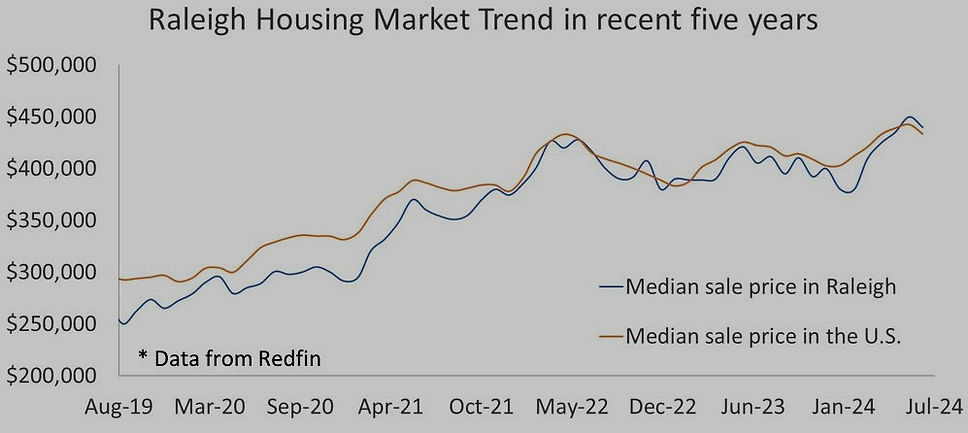
The Research Triangle area is renowned for its excellent school districts, top-tier healthcare facilities, and abundant recreational opportunities. The region offers a vibrant cultural scene, blending a lively urban atmosphere with access to natural beauty. Raleigh, the capital, is celebrated for its stunning historical architecture and is home to numerous free public museums, offering residents a rich selection of educational and cultural experiences. For sports fans, attending a Duke basketball game at Cameron Indoor Stadium or a UNC basketball game at the Dean Smith Center is a must—these events are legendary in the Triangle, showcasing the area’s deep passion for college sports and community spirit.
The Triangle region enjoys a temperate climate that offers the charm of all four seasons without harsh extremes. Winters are mild, with occasional light snow that melts quickly, and temperatures ranging from the mid-30s to mid-50s Fahrenheit, making outdoor activities comfortable. Summers are warm but not oppressive, with average temperatures in the mid-80s to low 90s Fahrenheit. This balanced climate supports year-round outdoor enjoyment and convenient living, enhanced by stunning springs, sunny summers, breathtaking autumns, and moderate winters.
Adding to the region's appeal is the convenience of Raleigh-Durham International Airport (RDU), just a short drive from most parts of the Triangle. As a major transportation hub, RDU offers numerous non-stop domestic flights to cities like New York, Chicago, and Los Angeles, along with international destinations in Europe, the Caribbean, and beyond. Whether for work, leisure, or hosting visitors, RDU ensures seamless global connectivity. With modern facilities prioritizing comfort, efficiency, and sustainability, the airport enhances life in the Triangle by providing easy access to world travel, all while allowing residents to enjoy the tranquility of a well-connected community.

Triangle Core Counties
As the most populous county in North Carolina, Wake County sits at the center of the thriving Triangle region and serves as a major economic and cultural hub within the Triangle. In 2024, Niche named Wake County the third-best county to live in across the entire United States, a testament to its exceptional quality of life. Residents benefit from a wealth of opportunities, including top-tier educational institutions, vibrant social scenes, and a robust job market, particularly in sectors like technology, research, and healthcare. Duke Energy, one of the largest power companies in the Triangle area, is the primary electricity provider for much of Wake County. Dominion Energy and Piedmont Natural Gas provides natural gas to most of Wake County residents. Wake County's blend of innovation, community, and accessibility makes it an ideal place to live, work, and thrive. For more detailed information on services, government resources, and living in Wake County, please visit the Wake County Official Website.
As the home of Durham city, Durham County is a key part of North Carolina's renowned Triangle region. It plays a significant role in the region's identity, particularly through its rich history, growing economy, and vibrant cultural scene. In 2024, Durham County has received 11 achievement awards from the National Association of Counties for its innovative approaches to local government. Durham is perhaps best known as the home of Duke University, a world-class institution that contributes to the area's reputation for academic excellence and research innovation. Durham County stands out for its entrepreneurial spirit, strong healthcare sector, and thriving arts and food scene, offering a unique blend of urban sophistication and Southern charm. For more information on services, government resources, and living in Durham County, please visit the Durham County Official Website. This site offers valuable insights into the county’s services, departments, and community programs.
Anchored by Chapel Hill, Orange County is home to the University of North Carolina at Chapel Hill (UNC), one of the nation’s oldest and most prestigious public universities. UNC plays a crucial role in shaping the identity of Orange County, significantly contributing to the region's reputation for academic leadership, research, and innovation. Hillsborough, the county seat, is a charming town rich in history and culture, offering a peaceful yet vibrant lifestyle. It also serves as a central hub for the county’s government and community services. The town of Hillsborough provides a unique blend of history, culture, and natural beauty, making it an attractive destination for those who appreciate a slower pace of life while still enjoying close connections to the broader Research Triangle area. Orange County, overall, provides a unique blend of urban and rural living, with small towns like Hillsborough standing out for their historical significance, local arts scene, and scenic landscapes. For more information on services, government resources, and living in Orange County, please visit the Orange County Official Website.
In summary, the Research Triangle area is a vibrant and growing region that combines a strong economy, world-class educational institutions, and an exceptional quality of life, making it an appealing destination for families, professionals, and students alike. Its seamless blend of innovation, culture, and natural beauty continues to establish the Triangle as one of the most desirable places to live in the country. The region’s thriving job market, paired with a lower cost of living compared to major tech hubs, reinforces its reputation as an ideal location for building fulfilling careers while enjoying a comfortable and balanced lifestyle. For more information, visit Research Triangle Website.
Triangle Area Housing Market
The following graphs are based on summary data from the Triangle area Multiple Listing Service (MLS). In the listing summary, the blue line in the left graph represents the number of active listings on the 15th day of each month during the specified 12-month period. For example, there were 11,487 active listings in the Triangle area MLS on September 15, 2024. The orange and gray lines in the left graph represent the number of new and sold listings each month during the specified 12-month period. For example, 4,929 new listings appeared, and 3,393 homes were sold in September 2024. In the right graph, the blue, orange, and grey lines represent the dollar values of active listings, new listings, and sold listings each month, respectively.
Triangle Market Trend : Listing Summary (December 2024)
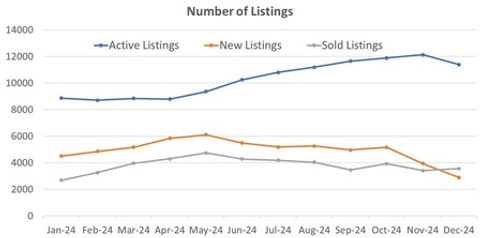
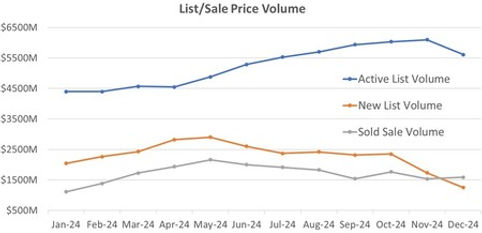
The number of new listings declined rapidly starting in October 2024, resulting in a significant decrease in active listings by December. Moreover, December 2024 marked the first time during the year that the number and dollar volume of sold listings surpassed those of new listings.
In the pricing summary, the blue line in the left graph represents the median dollar values of active listings on the 15th day of each month, while the orange and gray lines show the median dollar values of new and sold listings each month. The right graph displays the sale-to-original-list-price ratio, which indicates the average percentage of the sale price relative to the original list price for homes sold each month. For example, in December 2024 the sale-to-original-list-price ratio reached a one-year low of 96.7% in the NC Triangle area.
Triangle Market Trend : Pricing Summary (December 2024)
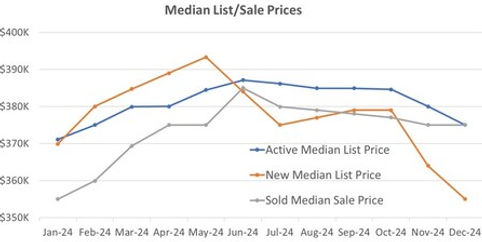
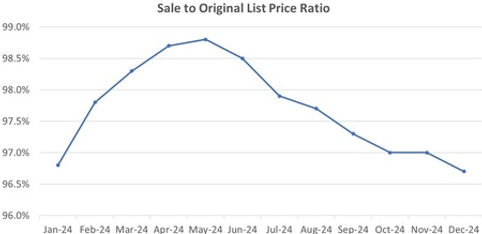
The price discount (the difference between the original list price and the sold price) peaked at 3.3% in December 2024, indicating that buyers recently had greater bargaining power.
In the timing measure, the monthly absorption rate is calculated by dividing the number of active listings on the 15th day of each month by the average number of sold listings each month over the previous 12 months. This rate estimates how long it might take to sell the current inventory. For example, a September absorption rate of 3.01 months suggests it could take about three months to sell the existing listings. The graph on the right shows the average number of days sold listings listed on the market. If a listing was temporarily off the market, those days are excluded. Unlike the absorption rate, the continuous days on market are not directly affected by inventory size.
Triangle Market Trend : Timing Measure (December 2024)
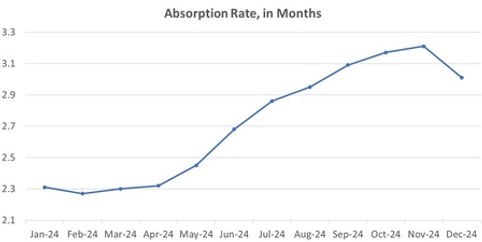

In December 2024, it took an average of 56.4 days to sell a home in the Triangle area, marking the longest duration in a year. Additionally, the absorption rate for Triangle area homes remained consistently above three months throughout the fourth quarter of 2024.
Market Demand Ratings as of September 2024
People familiar with the real estate market in North Carolina's Triangle area may notice an interesting phenomenon: housing market trends can vary significantly across cities and towns within the region. For example, in 2024, Raleigh averaged 551.1 homes sold per month compared to 1,429.3 homes listed for sale, resulting in a monthly sales ratio of less than 40%. In contrast, nearby towns like Apex and Holly Springs had average monthly sales ratios exceeding 75%. This data highlights how cities and towns within the NC Research Triangle area can experience distinct market trends during the same period.
In the following analysis, Triangle Homes studied the real estate markets of various cities and towns in the NC Research Triangle area from October 2023 to September 2024. We focused on the number of listings, home prices, and days on the market, and assessed market demand for each location. The ratings, with A being the highest grade, correspond to high market demand. The market demand ratings for September 2024 are as follows: Raleigh is rated D (last quarter: C-), Cary is rated B (last quarter: A), Morrisville is rated C (last quarter: B-), Apex is rated A- (last quarter: A), Holly Springs is rated B+ (last quarter: A), Fuquay-Varina is rated D+ (last quarter: D+) , Garner is rated D (last quarter: C-), Wake Forest is rated D (last quarter: D-), Durham is rated C (last quarter: C+) and Chapel Hill is rated C- (last quarter: B-). Triangle Homes provide quarterly updates on the real estate market analysis for the Research Triangle area to better understand the market trends and changes in this region. Previous quarterly market analysis is archived in the market archives.